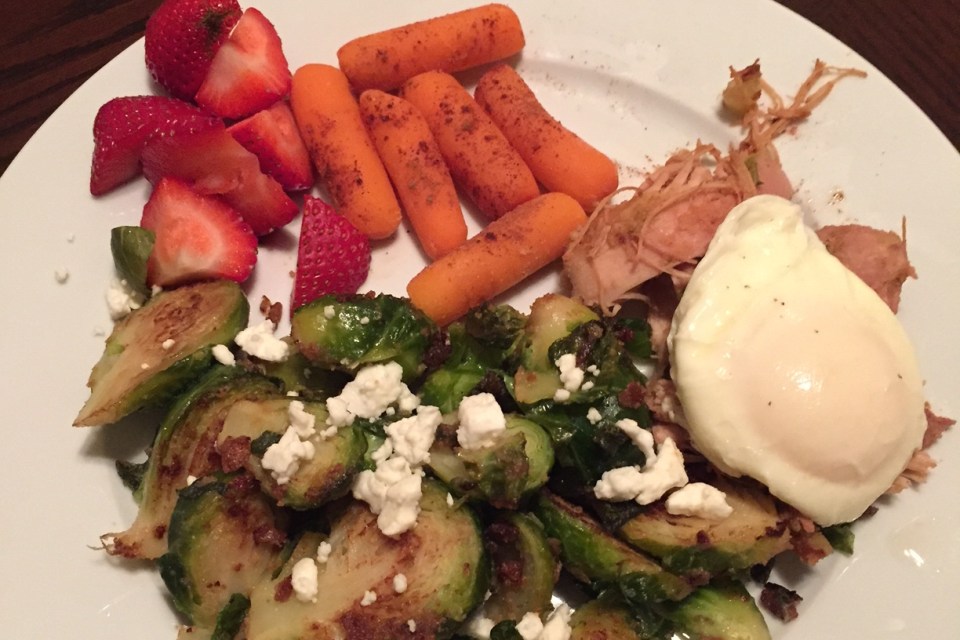Once you’ve gotten down the art of self-monitoring and portioning out your foods, the next level is to really take a hard look at what is actually on your plate.
See…here’s the thing. Could you lose weight eating only 1200 calories of twinkies? Sure. But can you keep the weight off that way? I seriously doubt it. Why? Because twinkies are designed to be addictive. They throw your blood sugar off balance. It’s not nutrient dense. So while you technically could keep to only 1200 calories, doing so will feel like torture. You will really and truly be fighting your physiology.
So how do you upgrade the quality of your meals? What does that even mean?
Well, let’s break this down in two parts. First – let’s look at foods individually.
There are Five Rules to Follow When Trying to Decide if the Food You Are Holding is “Whole” Food:
1) If you cannot pronounce and identify it…you probably don’t need to eat it. Can you pronounce and identify all the ingredients? Look and see. If you see a bunch of ingredients you aren’t familiar with…you’re probably not looking at an ideal food. I don’t say this because I KNOW it is bad. A lot of companies put the full name for vitamins in the ingredient list and they seem harmless enough. But a good way to think about this is similar to a person out in the jungle. Are you going to pick any wild mushroom or berry? Probably not. If you were a mushroom specialist and felt confident you would select well…then great! In the same way, I dated a biochemist, once, who was able to identify all the ingredients in the list. Good for him! But the rest of us mere mortals may as well stay away.
2) Make sure there is no sugar in the first three ingredients. If sugar is in the first three ingredients, are you going to die? No. But what you should know is that the food in your hands is not a food. It is a dessert. And eating foods that are proportionally high in sugar (I’m not talking about fruit, here, folks…I’m talking about processed foods) are honestly toxic to the body. That’s right…I said toxic. Thus, for good health, you don’t want to eat any more than 10% of calories in the form of added sugar. (If you were eating 1200 calories per day, that’s only 120 calories. That is ONE cookie.) And be careful. Just because it doesn’t say the word “sugar” doesn’t mean it isn’t sugar. There are over 50 names for sugar that the food industry uses in the ingredient list.
Don’t believe me that sugar is a problem? And if you don’t want to take my word for it, take the word of a medical researcher and pediatric endocrinologist: Dr. Robert Lustig.
3) There should be at least 3 grams of fiber AND/OR 6 grams of protein for every 100 calories. Why? Well…if a food has at least 3 grams of fiber, it probably is pretty darn close to a real food. Refined foods often strip out the fiber. Fruits, vegetables, whole grains….they all have fiber. Want to know what the big deal is about fiber? See my article on the benefits of fiber. Meanwhile, foods like eggs and meat might not have fiber, but they are still considered whole foods. They don’t have fiber, but they do have protein which offers a number of health benefits on its own.
4) Make sure there are no trans fats in it. Most things we eat…we can have in moderation. That is simply not the case with trans fats. There is NO amount of trans fats that we should take into our bodies. How can you identify a trans fat? Look at the ingredients. If you see anything that says “hydrognated oils” in it – put that thing down and move in the opposite direction. To be clear – “Trans Fats” are not to be confused with other perfectly healthy fats that our bodies do need.
5) If at all possible – try to find foods that have five ingredients or less. All foods are, in some way, shape, or form, processed. If you cook them – you processed them. But there is a difference between processing food yourself (i.e. mixing ingredients yourself and baking them in the oven) and buying industrialized, processed food (which will often include a plethora of additives that may or may not be good for you). In general, the more ingredients a food has, the more processing that likely took place. And the more processing that takes place, the farther we are away from eating foods that our bodies were designed to digest and absorb.
After finding ingredients that you feel confident are, in fact, real food – now it’s about putting those ingredients together in a way that is likely to balance your blood sugar and optimize your metabolism.
There are three primary macronutrients (carbs, protein and fat). Depending on who you ask, AND on what you are trying to achieve in your health…the ratios that people recommend change.
The standard ratio that is given (the same ratio you will see recommended in, say, My Fitness Pal or Lose It) break down to:
45 – 65% carbohydrates
20 – 35% fat
10 – 35% protein
If you’re anything like me and want to get into the nitty gritty details about each of those…I wrote article on each one. Just click on any of the links. If you’ve got a pretty good handle on each of those…then let’s just say that a plate that was following that ratio would look something like this:
(Harvard’s Healthy Eating Plate Model)
http://www.health.harvard.edu/media/content/images/healthy-eating-plate-web1000.jpg
The vegetables represent a combination of carbs and protein. As do the grains. The fruit is a firm carb. The meat serves as a solid protein. There is some oil you can sprinkle over the whole meal (a little butter on the veggies).
And the real food version of this would like the featured image in this blog (just in case you were curious).
So let’s break this down using an example.
First – you need to know how many calories you needs (That’s level 1) You can do that using:
Second – Decide how to distribute those calories in terms of protein, carbs, and fats. For that, I would highly recommend using the USDA interactive DRI. You can check off protein, fats, carbs….you can even check off certain vitamins and minerals if you’re curious about how much you should be taking of each.
Third – It helps if you can get that broken down into actual food.
- My Food Plate has a terrific tool for that. You can enter your information and it will give you a breakdown of how many calories you should eat and servings of each food group you should have within that calorie allowance.
Or – if you don’t really like having it broken down into food groups, but want to see how that would look on a plate (but broken down in terms of calories) here is an example:
- A 1200 Calorie/Day plan broken down into three meals would be 400 cals each.
- An example of a day’s worth of 400 calorie meals that follows approximately the right ratio of food groups would include:
- Breakfast Burrito (400 calories)
- 2 eggs (140 calories)
- 1 cup frozen spinach – scrambled with eggs (35 calories)
- 1 whole wheat tortilla wrap (150 calories)
- 1 oz. of feta cheese (75 calories)
- Chicken Salad (400 calories)
- 1.3 cup romaine lettuce (10 calories)
- 3 oz. chicken breast (140 calories)
- 1 roma tomato (35 calories)
- 3 mini sweet bell peppers (30 calories)
- 2 teaspoons parmesan cheese (15 calories)
- 1.5 teaspoon olive oil (60 calories)
- 2 teaspoons balsamic vinegar (10 calories)
- 1/2 granny smith green apple (50 calories)
- 1/2 cup of sweet potato (55 calories)
- Salmon Dinner (400 calories)
- 2.5 ounces of salmon (150 calories)
- 2/3 cup of brown rice (150 calories)
- 1 cup of steamed broccoli (30 calories)
- 2 teaspoons butter – for broccoli and rice (70 calories)
- Breakfast Burrito (400 calories)
The Cliff Notes Version is this:
- With weight loss, the first thing to consider is the quantity of calories that you are consuming.
- Once you get the hang of that, the best way to sustain your progress AND feel satisfied and energized while you do it is to look at the quality of those ingredients.
- When looking at the quality of each ingredient individually follow the five rules from above.
- To create an optimal snack or meal (combining individual ingredients for the best outcome) you want to pair (at the very least) these two things:
Once you get the hang of this – the final level is “Customization”

